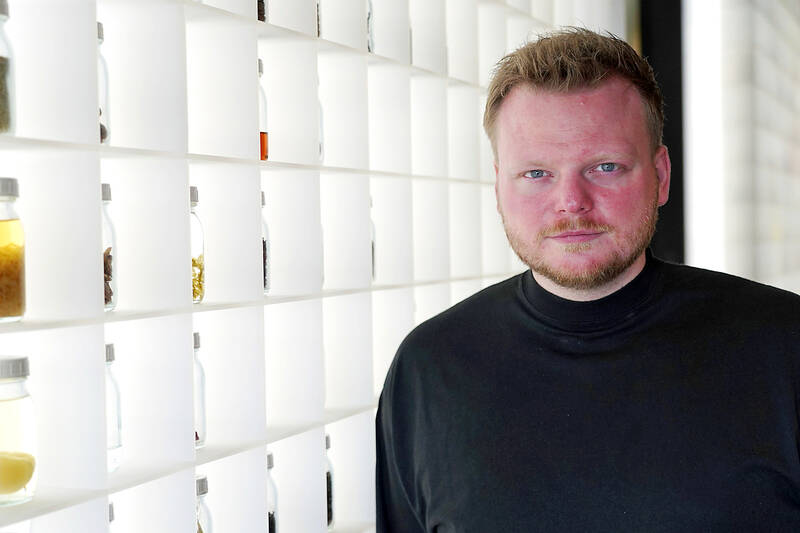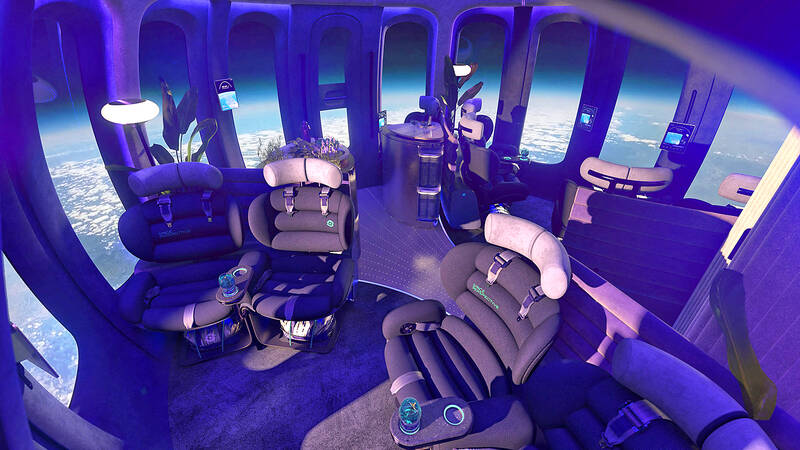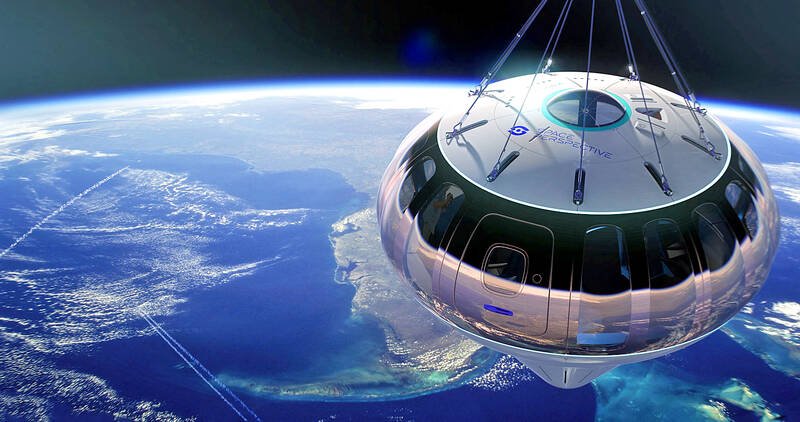Ever since humans have journeyed to space, their meals there have proved to be, well, nothing to write home about.
That could change after a Michelin-starred chef teamed up with the Florida-based start-up Space Perspective to take fine-dining to the upper atmosphere late next year.
Six guests are set to ascend aboard Spaceship Neptune to the stratosphere, where they would enjoy an immersive dining experience served up by Danish Michelin-starred chef Rasmus Munk.

Photo: AP
Munk, 33, would travel with the guests in the capsule and serve the meal himself, from a small kitchen.
He said his menu would be inspired by the impact of space innovation.
“We want to tell stories through the food,” Munk said. “We … want to talk and highlight some of the research that’s been done through the last 60 years.”

Photo: AFP / Space Perspective
“I think that will make an even stronger impact when you’re up there and looking down,” he said.
Spaceship Neptune is more of a balloon than a rocket. The company says its pressurized capsule, attached to a balloon, would lift to an altitude of about 30,480m above sea level where guests would dine while watching the sun rise over the curvature of the Earth.
Organizers are promising an out-of-this-world experience for those with an appetite for adventure, but such an astronomic menu comes with a fittingly astronomic price tag — US$495,000 per ticket.

Photo: AFP / Space Perspective
They say the trip is to last six hours and that they are still in discussion with potential participants.
It is one of the latest offerings by private firms that include Blue Origin Enterprises LP, Virgin Galactic Holdings Inc and Space Exploration Technologies Corp.
The flight would not technically reach “space.” Spaceship Neptune would ascend to about 30km, well below the Karman line, the boundary separating Earth’s atmosphere and outer space, which is about 100km from Earth.
Munk’s menu is expected to be a far cry from meals eaten by astronauts.
The first man in space, Soviet cosmonaut Yuri Gagarin, squeezed beef and liver paste into his mouth from an aluminum tube.
To save on weight, astronauts aboard the International Space Station (ISS) usually dine on dishes packaged in rehydratable containers, including soups and casseroles.
There have been some exceptions. In 2006, French master chef Alain Ducasse created special gourmet food that could be used for celebratory meals aboard the ISS. The tinned dishes included typical Mediterranean ingredients, such as olives, tomatoes, quails and swordfish.
Although Munk is mysterious about his menu, he said he is planning to incorporate glow-in-dark stars made from aerogel and jellyfish protein.
“We are also working on an edible piece of space junk from a satellite,” he said.
“And then, we want to talk about some of the things going on on the planet ... from deforestation to temperatures rising and the garbage in our seas,” he added.
Munk’s Alchemist restaurant in Copenhagen has held two Michelin stars since 2020, and last year was ranked fifth-best restaurant in the world.
Guests dine on a menu of 50 edible “impressions,” and the experience is accompanied by performers and installations, all set in the restaurant’s own architecture — a former theater set building workshop in Copenhagen.
At the restaurant’s center is a large planetarium dome, where guests eat surrounded by projections of Earth seen from space, oceans, forests and even a beating heart.
“I think fine dining, in general, is changing a lot,” Munk said. “And I think you, as a guest, require more an experience in the future.”
Danish food and wine writer Rasmus Palsgaard said gastronomy is becoming more about the experience, and less about what is on the plate.
“More wealthy people or big companies have a desire to really create something special that is more than a meal,” he said. “It’s about much more than just the food being served in front of you.”

The US dollar was trading at NT$29.7 at 10am today on the Taipei Foreign Exchange, as the New Taiwan dollar gained NT$1.364 from the previous close last week. The NT dollar continued to rise today, after surging 3.07 percent on Friday. After opening at NT$30.91, the NT dollar gained more than NT$1 in just 15 minutes, briefly passing the NT$30 mark. Before the US Department of the Treasury's semi-annual currency report came out, expectations that the NT dollar would keep rising were already building. The NT dollar on Friday closed at NT$31.064, up by NT$0.953 — a 3.07 percent single-day gain. Today,

‘SHORT TERM’: The local currency would likely remain strong in the near term, driven by anticipated US trade pressure, capital inflows and expectations of a US Fed rate cut The US dollar is expected to fall below NT$30 in the near term, as traders anticipate increased pressure from Washington for Taiwan to allow the New Taiwan dollar to appreciate, Cathay United Bank (國泰世華銀行) chief economist Lin Chi-chao (林啟超) said. Following a sharp drop in the greenback against the NT dollar on Friday, Lin told the Central News Agency that the local currency is likely to remain strong in the short term, driven in part by market psychology surrounding anticipated US policy pressure. On Friday, the US dollar fell NT$0.953, or 3.07 percent, closing at NT$31.064 — its lowest level since Jan.

The New Taiwan dollar and Taiwanese stocks surged on signs that trade tensions between the world’s top two economies might start easing and as US tech earnings boosted the outlook of the nation’s semiconductor exports. The NT dollar strengthened as much as 3.8 percent versus the US dollar to 30.815, the biggest intraday gain since January 2011, closing at NT$31.064. The benchmark TAIEX jumped 2.73 percent to outperform the region’s equity gauges. Outlook for global trade improved after China said it is assessing possible trade talks with the US, providing a boost for the nation’s currency and shares. As the NT dollar

The Financial Supervisory Commission (FSC) yesterday met with some of the nation’s largest insurance companies as a skyrocketing New Taiwan dollar piles pressure on their hundreds of billions of dollars in US bond investments. The commission has asked some life insurance firms, among the biggest Asian holders of US debt, to discuss how the rapidly strengthening NT dollar has impacted their operations, people familiar with the matter said. The meeting took place as the NT dollar jumped as much as 5 percent yesterday, its biggest intraday gain in more than three decades. The local currency surged as exporters rushed to